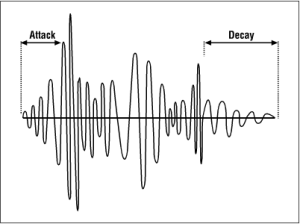- Zoom
Transients Preservation
Transients can be attack or decay transients. Signals can have transients, and noise. These are two different components, which can be confused at the analysis. In order to evaluate the respective noise and transient rate in the signal, a statistic model is used. The transients detection is based on the energy concentration at the right of the analysis window, which is calculated for each frequency bin. At each step of the analysis, the beginning of an event located from the right to the center of the window is considered as a transient. The localisation of the energy is calculated from normalized values from 1 to 10. Ideally, there shouldn't be any noise or residual sound, and a transient is equivalent to an energy decrease from a 10 to 1 factor, from the right to the center of the window. Yet, the noise in the signal causes a decrease of the maximum value of the normalized energy. The higher the ratio of the amplitude of the event to noise of the signal, the higher the maximum value is. The transients preservation section of the Processing Parameters window allows to manage the way transients are rendered when processing a signal. It depends on the transients detection, and requires the To get full information about transients detection, refer the corresponding sections |  |
